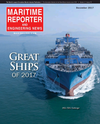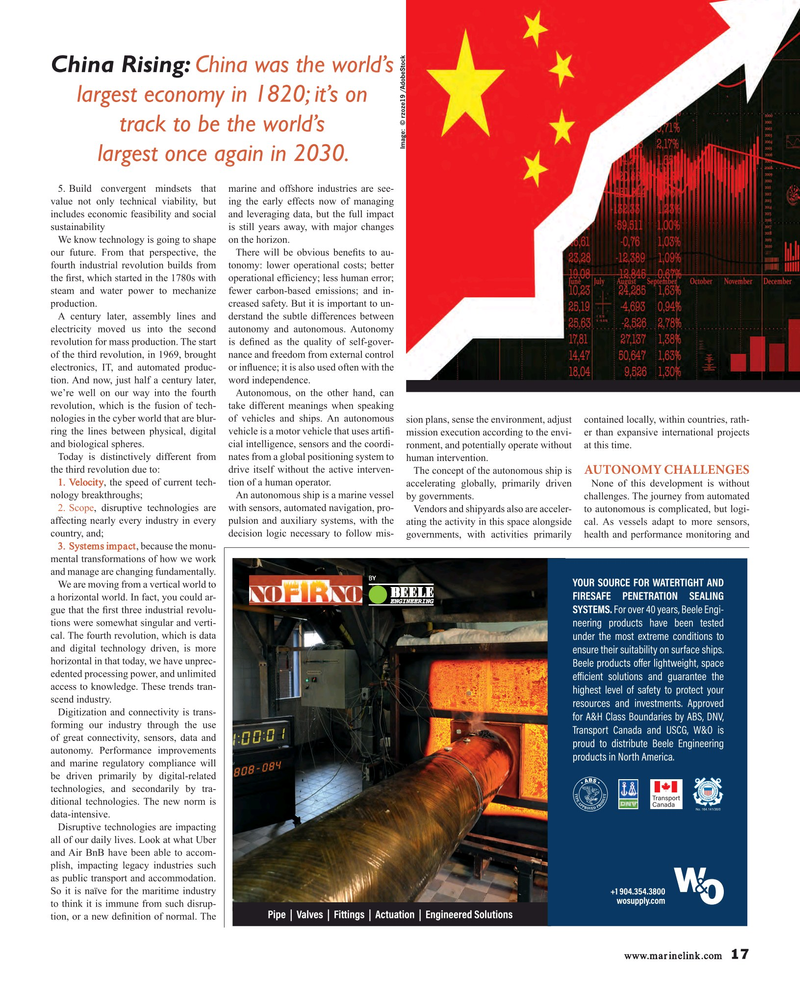
Page 17: of Maritime Reporter Magazine (December 2017)
U.S. Navy Quarterly
Read this page in Pdf, Flash or Html5 edition of December 2017 Maritime Reporter Magazine
China Rising: China was the world’s largest economy in 1820; it’s on track to be the world’s
Image: © rzoze19 /AdobeStock largest once again in 2030. 5. Build convergent mindsets that marine and offshore industries are see- value not only technical viability, but ing the early effects now of managing includes economic feasibility and social and leveraging data, but the full impact sustainability is still years away, with major changes
We know technology is going to shape on the horizon.
our future. From that perspective, the There will be obvious bene? ts to au- fourth industrial revolution builds from tonomy: lower operational costs; better the ? rst, which started in the 1780s with operational ef? ciency; less human error; steam and water power to mechanize fewer carbon-based emissions; and in- production. creased safety. But it is important to un-
A century later, assembly lines and derstand the subtle differences between electricity moved us into the second autonomy and autonomous. Autonomy revolution for mass production. The start is de? ned as the quality of self-gover- of the third revolution, in 1969, brought nance and freedom from external control electronics, IT, and automated produc- or in? uence; it is also used often with the tion. And now, just half a century later, word independence.
we’re well on our way into the fourth Autonomous, on the other hand, can revolution, which is the fusion of tech- take different meanings when speaking of vehicles and ships. An autonomous sion plans, sense the environment, adjust contained locally, within countries, rath- nologies in the cyber world that are blur- ring the lines between physical, digital vehicle is a motor vehicle that uses arti? - mission execution according to the envi- er than expansive international projects and biological spheres. cial intelligence, sensors and the coordi- ronment, and potentially operate without at this time.
Today is distinctively different from nates from a global positioning system to human intervention.
the third revolution due to: drive itself without the active interven-
The concept of the autonomous ship is AUTONOMY CHALLENGES 1. Velocity, the speed of current tech- tion of a human operator.
accelerating globally, primarily driven None of this development is without
An autonomous ship is a marine vessel by governments. challenges. The journey from automated nology breakthroughs; 2. Scope, disruptive technologies are with sensors, automated navigation, pro-
Vendors and shipyards also are acceler- to autonomous is complicated, but logi- affecting nearly every industry in every pulsion and auxiliary systems, with the ating the activity in this space alongside cal. As vessels adapt to more sensors, country, and; decision logic necessary to follow mis- governments, with activities primarily health and performance monitoring and 3. Systems impact, because the monu- mental transformations of how we work and manage are changing fundamentally.
We are moving from a vertical world to a horizontal world. In fact, you could ar- gue that the ? rst three industrial revolu- tions were somewhat singular and verti- cal. The fourth revolution, which is data and digital technology driven, is more horizontal in that today, we have unprec- edented processing power, and unlimited access to knowledge. These trends tran- scend industry.
Digitization and connectivity is trans- forming our industry through the use of great connectivity, sensors, data and autonomy. Performance improvements and marine regulatory compliance will be driven primarily by digital-related technologies, and secondarily by tra- ditional technologies. The new norm is data-intensive.
Disruptive technologies are impacting all of our daily lives. Look at what Uber and Air BnB have been able to accom- plish, impacting legacy industries such as public transport and accommodation.
So it is naïve for the maritime industry to think it is immune from such disrup- tion, or a new de? nition of normal. The www.marinelink.com 17
MR #12 (10-17).indd 17 MR #12 (10-17).indd 17 12/6/2017 11:18:01 AM12/6/2017 11:18:01 AM

 16
16

 18
18
